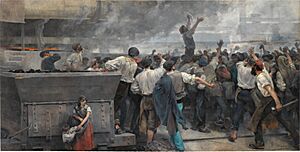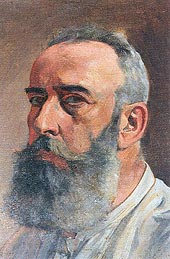Vicente Cutanda facts for kids
Vicente Cutanda y Toraya (born in 1850, either in Cella or Madrid; died in 1925 in Toledo) was a Spanish artist. He was known for his paintings and watercolors. Vicente Cutanda is famous for creating historical scenes and pictures that showed the lives of everyday working people. This style of art is called social realism. He often found ideas for his paintings in the Basque country, especially in Biscay.
Early Life and Art Training
Vicente Cutanda was the only child of Vicente Cutanda y Jarauta, a well-known expert in plants. When he was a child, he had a nervous problem that affected his eyesight.
He first started studying to become an architect. However, he soon changed his mind and decided to study painting instead. He went to the Real Academia de Bellas Artes de San Fernando, which is a famous art school. There, he was inspired by the paintings of Eduardo Rosales.
Developing His Painting Style
When Vicente Cutanda first moved to Toledo, he was asked to paint many religious pictures. In 1884, he became a drawing teacher at a group called the Co-operative Workers' Society in Toledo. This allowed him to marry Luisa Salazar, his girlfriend since childhood.
He was good friends with another painter named Ricardo Arredondo Calmache. This friendship helped him change his painting style. He moved away from the style of Rosales and started focusing on social realism. This means he painted scenes that showed the real lives and struggles of ordinary people.
His interest in social realism grew even more when he visited Italy. He studied at the Regio Instituto delle Belle Arte de Roma, an art school he could attend thanks to a scholarship he worked hard to get. In 1891, his focus on social realism was fully confirmed when a very important letter from the Pope, called Rerum novarum, was released. This letter talked about the lives of working people.
Awards and Later Career

Vicente Cutanda won an award at the National Exhibition of Fine Arts in 1887. He received a Third Class prize for his painting, "At the Feet of the Savior." Five years later, in 1892, he won an even bigger award: a First Class prize. This was for his painting "A Workers' Strike in Vizcaya," which was his first major work in the social realist style.
In 1900, he became a drawing professor at the Instituto General y Técnico de Segovia. From 1903 to 1904, he was the director of the School of Arts and Crafts in Logroño. When he returned to Toledo, he became a professor teaching "Special studies of drawing and decorative composition" at the Higher School of Industrial Arts.
Later in his life, he became a member of the Royal Academy of Fine Arts and Historical Sciences of Toledo. He also worked on the Monuments Commission, helping to restore old buildings and artworks. For the last 30 years of his life, he drew pictures for magazines like La Ilustración Artística and Blanco y Negro.
See also
 In Spanish: Vicente Cutanda para niños
In Spanish: Vicente Cutanda para niños



